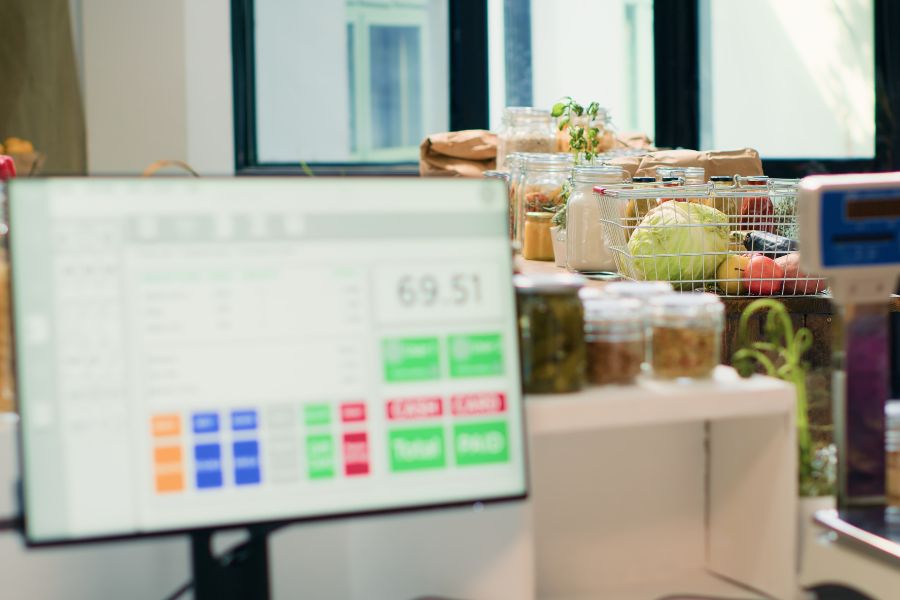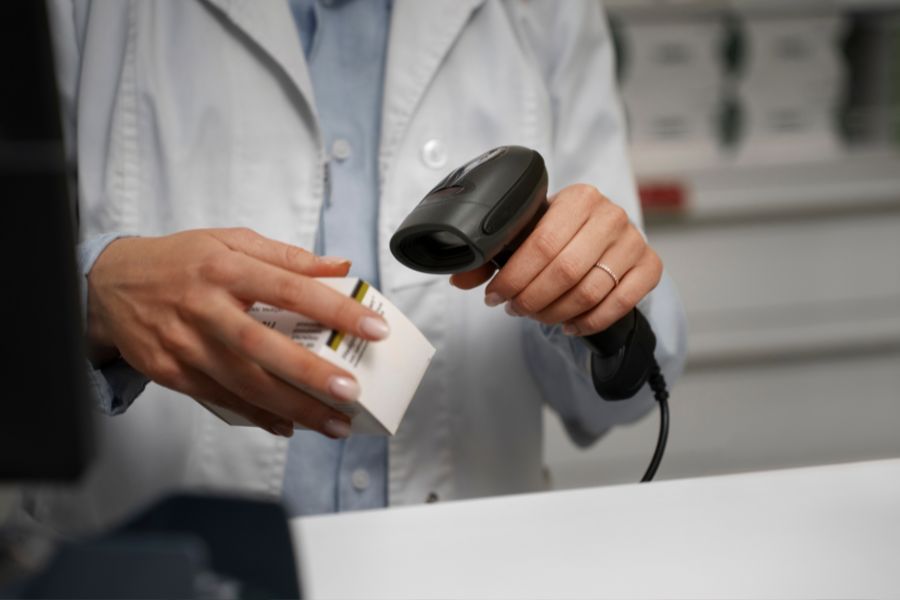In today’s fast-paced retail and hospitality industries, uninterrupted transactions are essential for a seamless customer experience. While cloud-based solutions dominate the market, an offline Point of Sale (POS) system ensures that businesses remain operational even when internet connectivity is disrupted.
This article delves into the key features and advantages of offline POS systems, highlighting their crucial role in enhancing transaction reliability, improving efficiency, and maintaining business continuity. Whether you’re running a retail store, restaurant, or multi-location business, understanding the power of offline POS technology can help you streamline operations and boost customer satisfaction.
What Is An Offline POS System And Its Benefits
The global point-of-sale market, valued at USD 11.99 billion in 2022, is projected to experience a compound annual growth rate (CAGR) of 10.8% from 2023 to 2030.
In the context of this evolving market, offline Point of Sale (POS) systems emerge as robust solutions, adept at facilitating transactions and overseeing business operations even in the absence of a continuous internet connection. Diverging from the reliance of traditional POS systems on constant internet access, offline POS systems present tailored advantages that cater to the needs of businesses operating in diverse environments.
Overview Of Offline POS Systems
An offline POS system serves as a resilient and versatile solution tailored to meet the needs of businesses operating in environments with unreliable or no internet connectivity. This technology is designed to ensure uninterrupted transaction processing and operational management, providing a reliable backbone for businesses facing challenges related to connectivity.
Key to its functionality is the system’s ability to conduct transactions seamlessly, independent of internet availability. This ensures that businesses can maintain operational continuity, preventing disruptions in the customer checkout process and fostering a positive customer experience.
Beyond transaction processing, an offline POS system offers robust inventory management capabilities. This includes the ability to monitor stock levels, track product movement, and synchronize data across different channels. This feature proves invaluable in optimizing inventory control and preventing stockouts, contributing to overall operational efficiency.
Enhanced data security is another critical aspect. By limiting exposure to potential online threats, businesses can protect sensitive customer information and maintain the integrity of their transactions. This focus on data security is essential for establishing and maintaining customer trust.
In summary, an offline POS system is a dependable tool, combining uninterrupted transaction processing, robust inventory management, and enhanced data security. This makes it an indispensable asset for businesses seeking efficient point-of-sale operations, especially in environments where internet connectivity may pose challenges.
Benefits Of An Offline POS System
An offline POS system refers to a system that can operate independently without a constant internet connection. While many businesses today use cloud-based POS systems, offline POS still has several benefits. Here are some advantages:
- Uninterrupted Operations: Offline POS systems ensure continuous transaction processing and operational management even during internet disruptions, eliminating the potential for sales interruptions.
- Flexibility: Mobility in Transactions: Whether engaging in pop-up events, mobile setups, or operating in remote locations, this kind of POS system provides the flexibility to execute transactions without the constraints of a stable internet connection.
- Enhanced Customer Experience: Citing research from PWC, 73% of individuals identify customer experience as a pivotal factor influencing their purchasing decisions. In light of this, Offline POS systems play a crucial role by enabling swift transaction processing, averting delays that might otherwise lead to customer frustration.
- Reduced Exposure to Threats: Operating offline minimizes the exposure of sensitive customer data to potential online threats, enhancing the security of information such as credit card details and maintaining customer trust.
- Operational Efficiency: These systems typically offer features like inventory management, enabling businesses to update stock levels, monitor sales, and manage inventory without an internet connection, thereby streamlining day-to-day operations.
- Business Insights: The best offline POS systems provide robust analytics and reporting capabilities. Businesses can extract valuable insights into sales trends, customer behavior, and inventory turnover, enabling informed decision-making.
- Cost-Effectiveness: In areas where high-speed internet is either costly or unreliable, an offline POS serves as a cost-effective alternative, saving businesses from the expenses associated with premium internet connectivity.
- Adaptability: Versatility Across Industries: These systems showcase adaptability across various industries, including retail, hospitality, and service-oriented businesses. This versatility positions them as valuable assets for businesses with diverse operational needs.
While offline POS systems offer these benefits, it’s essential for businesses to carefully weigh their specific requirements, the nature of their operations, and the potential limitations of offline systems before making a decision. In some cases, a hybrid approach that combines offline capabilities with occasional online synchronization may be a suitable compromise.
What Are The Components Of An Offline POS System?
Hardware Components
An offline POS system requires several hardware components to facilitate seamless transactions and efficient business operations. The essential hardware components typically include:
- POS Terminal: This central component is the physical point where transactions occur. It typically includes a touchscreen interface for entering transaction details and processing payments.
- Cash Drawer: An essential hardware component that securely stores cash during transactions. It is usually connected to the POS terminal and opens automatically upon completing a sale.
- Receipt Printer: This device generates transaction receipts for customers, providing a record of the purchase. Receipts can be printed on paper or sent digitally, depending on the business’s preference.
- Barcode Scanner: Commonly used in retail environments, a barcode scanner allows for the swift and accurate recording of product information during the checkout process.
- Card Reader/Chip Reader: This component enables the POS system to process credit and debit card transactions securely. It may support traditional magnetic stripe cards as well as modern chip and contactless cards.
- Label Printer (Optional): For businesses with extensive inventory, a label printer can be used to generate product labels with barcodes, facilitating efficient tracking and management.
- Mobile Devices (Optional): Some systems support mobile devices such as tablets or smartphones, providing additional flexibility for businesses to process transactions on the go.
Software Components
The software components of an offline POS system typically include:
- Offline POS Software: The core software runs on the POS terminal, allowing businesses to process transactions even without an internet connection. It includes features for itemizing sales, applying discounts, and managing payment methods.
- Inventory Management System: This software component tracks the quantity and status of products in stock. It enables businesses to manage inventory levels, monitor product turnover, and automate reordering processes.
- Sales Reporting and Analytics: POS systems often include reporting tools that offer insights into sales trends, popular products, and customer behavior. These analytics aid businesses in making informed decisions.
- Security Features: Security measures such as data encryption and user authentication ensure the protection of sensitive customer information, safeguarding against potential breaches.
- User Authentication: This feature allows businesses to set up user accounts with different access levels, ensuring that only authorized personnel can perform certain functions within the POS system.
- Offline Database: The system stores essential data locally, allowing for seamless transactions and operational management during periods of no internet connectivity. This local storage prevents interruptions in service.
- Integration Capabilities: POS systems may integrate with other tools and services such as accounting software, enabling businesses to streamline operations and reduce manual data entry.
- Update and Sync Functionality: When internet connectivity is restored, this feature allows the POS system to sync data with a central server, ensuring consistency across multiple locations and updating information.
- Customer Relationship Management (CRM) (Optional): For businesses focused on customer engagement, a CRM component helps manage and analyze customer interactions, preferences, and purchase history.
In summary, the synergy of these hardware and software components in an Offline POS System provides businesses with a comprehensive toolset for conducting transactions, managing inventory, and ensuring a seamless customer experience even when internet connectivity is unreliable or unavailable.
How To Choose The Right Offline POS System For Your Omnichannel Business
Offline POS system exhibits varying levels of functionality and complexity, serving different purposes in the retail landscape. While some are tailored exclusively for physical retail, others are optimized for online sales. For e-commerce businesses with both virtual and brick-and-mortar components, having an integrated POS system capable of seamlessly handling both offline and online transactions is crucial.
Fundamental POS System Functions
- Product Identification: Initiating a sales transaction requires identifying each purchased item. This can involve manual entry of product details, scanning barcodes, or referencing digital shopping carts.
- Transaction Management: After product selection, a POS must calculate total prices, assess additional fees (e.g., services, customization, or fulfillment costs), and apply tax calculations. Handling discounts from coupons, sales, or promotional codes is integral at this stage.
- Payment Processing: The offline POS system must securely accept and process payments, including cash, checks, credit cards, debit cards, and online payment gateways like PayPal or Stripe. This is a critical stage in the purchasing process.
- Receipt Creation: Post-payment, the POS generates a record for both the customer and the seller, whether in the form of a physical receipt, email, or SMS message. Some systems offer customers the option to forgo a receipt, but the purchase is always recorded for reporting and accounting purposes.
Additional POS System Functions
- Returns, Exchanges, and Refunds: Most POS systems facilitate refunds, with advanced features enabling transactions like product-for-product exchanges, store credit issuance, and handling returns.
- Inventory Management: Post-transaction, many POS systems automatically update business-wide inventory levels, aligning with merchandise that has been sold or returned.
- Customer Loyalty Programs: Certain offline POS systems enable customers to connect purchases to a loyalty or rewards account using identifiers like phone numbers, loyalty cards, or payment methods. This not only enhances customer benefits but also provides valuable data for targeted marketing and customer retention strategies.
Recognizing the diversity among POS systems is essential. When evaluating the best fit for your omnichannel needs, ensure the chosen POS possesses the full range of functionality to optimize the relationship between your online and physical retail stores. Additionally, selecting a POS system that seamlessly integrates with your omnichannel e-commerce growth platform can elevate scalability and profitability to new heights.
Top 5 Best Offline POS Systems
Selecting the right offline POS System is paramount for seamless transactions and efficient management. Among the top contenders in this space, we present five leading solutions, each tailored to meet diverse business needs.
ConnectPOS
ConnectPOS stands out as a top-tier cloud POS system that facilitates seamless offline purchases when internet connectivity is unavailable. In offline mode, ConnectPOS empowers merchants to effortlessly view products, add them to the cart, search for existing customers, and process regular payments.
All essential functions perform efficiently in offline mode, with data stored locally on the device and synchronized with the cloud once an internet connection is re-established.
The offline mode proves invaluable for businesses operating in dynamic settings like trade shows or pop-up stores, where internet connectivity may be unreliable. ConnectPOS ensures adaptability by allowing sellers to easily switch between online and offline modes based on their specific needs.
Upon reconnecting to the internet, the offline POS system of ConnectPOS seamlessly transitions from offline to online mode, updating previously saved offline data on the inventory system. This ensures that business owners have comprehensive and accurate POS reports at the end of each day.
Adding to its robust features, ConnectPOS leverages cutting-edge Google technology to enhance the sales page loading mechanism. In cases of sluggish transfer speeds, the system retrieves data from the previous cache and promptly compares it with the new data. This real-time comparison ensures that any changes are immediately reflected.
Consequently, users can efficiently and rapidly access the sales website, even in locations with slow 3G connections. ConnectPOS stands at the forefront, providing a reliable and adaptive solution for businesses navigating the challenges of offline transactions and varying internet speeds.
CAKE POS
Among the top offline POS Systems, CAKE POS stands out as a versatile solution tailored for independent and mid-size restaurant chains. Its cloud-based technology not only replaces existing systems for independent owners but also introduces faster and more organized restaurant management.
This results in quicker table turns and increased revenue for small to mid-size chains, showcasing CAKE’s robust software. The system features a durable, bezel-less 15-inch touchscreen, enabling staff to seamlessly handle various tasks such as placing orders, managing reservations, processing payments, modifying items, and organizing labor cost reporting.
Additionally, CAKE POS offers owners an intuitive reporting and dashboard system for in-depth business analysis.
Cin7 Omni
Cin7 Omni provides unique benefits, allowing users to mark stock with custom statuses and sell directly from distribution center stock when shop stock is insufficient.
This system processes sales over multiple channels in real-time, maintaining accurate stock figures across multiple branches within a single Cin7 account. With the flexibility to buy and sell stock in different units, Cin7 ensures seamless tracking based on the main unit of measure, even when offline.
Loyverse POS
The offline POS system of Loyverse POS, designed for managing multiple stores under a single account, empowers owners with comprehensive insights. By tracking sales, inventory, customers, and employees in one centralized location, Loyverse aids in informed decision-making.
The platform is accessible via various devices, including iPhones, iPads, Android smartphones, or tablets. With features such as the customer app Loyalty Ocean for private feedback and direct message marketing capabilities, Loyverse enhances customer engagement and promotional efforts.
Bravo Store Systems
Bravo Store Systems, specializing in pawn operations, offers online loan tracking, detailed transaction histories, and versatile reporting capabilities. With the ability to generate custom reports and view performance snapshots, Bravo Store Systems ensures a comprehensive understanding of business metrics.
The system is designed to provide a seamless and efficient experience for both customers and business owners in the dynamic landscape of pawn operations.
Whether you’re in the restaurant industry, retail, or pawn operations, these top 5 offline POS systems offer unparalleled features and benefits. Elevate your business operations, streamline transactions, and enhance overall efficiency with a robust POS System designed to meet the demands of modern commerce.
FAQs About Offline POS Systems
1. What Are The Main Features Of An Offline POS System?
An offline POS system typically includes key features such as seamless transaction processing without internet dependency, robust inventory management capabilities, enhanced data security, user-friendly interfaces, and the ability to generate receipts. It ensures operational continuity even in environments with unreliable or no internet connectivity.
2. What Is The Difference Between An Online System And An Offline System?
The primary distinction lies in their dependency on internet connectivity. Online POS systems require a constant internet connection for transaction processing and data synchronization, while offline POS systems can operate independently during internet outages. Offline systems store data locally and sync with a central server when connectivity is restored.
3. What Is The Advantage Of An Offline Processing System?
The main advantage of an offline processing system is its resilience in environments with unreliable or no internet connectivity. It ensures uninterrupted operations, allowing businesses to process transactions, manage inventory, and provide services without dependency on a constant internet connection.
4. How Much Does A POS System Cost?
POS system costs vary based on factors such as the provider, features offered, and the scale of your business. The pricing spectrum varies, ranging from a few hundred to several thousand dollars. Some providers may also offer subscription plans, which can be a more cost-effective option for businesses.
5. How To Choose The Best Offline POS System For Your Business?
Choosing the best POS system involves considering factors such as the nature of your business, industry requirements, scalability, ease of use, integration capabilities, and budget constraints. Assess your specific needs and carefully compare features and reviews of different systems before making a decision.
6. Does ConnectPOS Have A Free Trial?
Yes, we have
Here’s a step-by-step guide to initiating your free trial:
- Schedule a call for a comprehensive demonstration of our robust features.
- Receive personalized recommendations tailored to your business objectives and specific requirements.
- Gain insights into our pricing structure and methodology during the consultation.
Conclusion
An offline POS system is essential for businesses operating in areas with unreliable internet connectivity. These systems ensure uninterrupted transactions, robust inventory management, and enhanced data security. Choosing the right POS system requires considering industry-specific needs, scalability, and integration capabilities. For more questions about ConnectPOS, feel free to contact us.
ConnectPOS is a all-in-one point of sale solution tailored to meet your eCommerce POS needs, streamline business operations, boost sales, and enhance customer experience in diverse industries. We offer custom POS with features, pricing, and plans to suit your unique business requirements.




